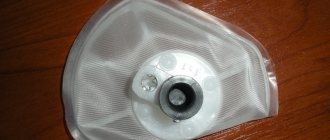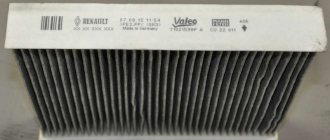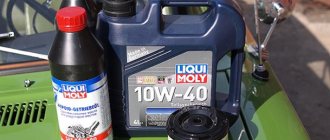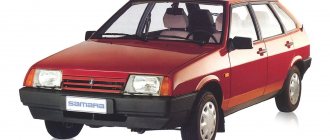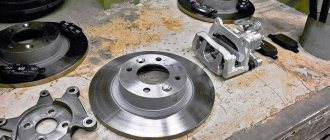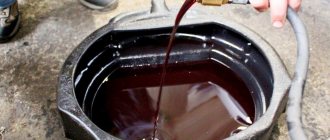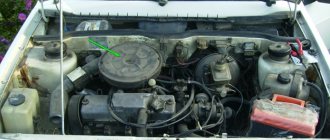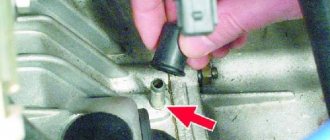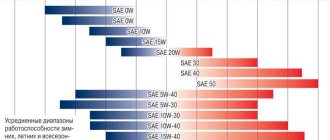Cars of the Lada Vesta family are equipped with oil filters of domestic and foreign production. Depending on the batch, the domestic “Livny” or the German “Mann” cleaner is installed.
Despite the fact that the quality of the imported filter (hereinafter referred to as MF) is not higher than the domestic one, many car owners still prefer German technologies.
Replacing the MF yourself is not difficult; it is quite feasible for a driver without the skills to maintain a vehicle. Prevention will take no more than 10 minutes, provided you have a special puller.
DSC_0431 (Copy)
If your car has an AMT, then the engine oil pan plug is made with a 17mm hex key.
If your car has an AMT, then the engine oil pan plug is made with a 17mm hex key.
Attention! Be careful - the oil is hot and harsh on the skin.
Drain the oil until it begins to drip from the drain hole. After wiping the plug and removing any remaining dirt from its thread, we wrap the plug in place. We remove oil leaks from the engine oil pan. We place a container for used oil in the area where the oil filter is located. In order not to damage the sensor wiring harness and the crankshaft position sensor itself...
Brief characteristics of filters
- Mann W914/2: German manufacturer, one of the main suppliers of consumables for Lada, VAZ. Good quality, affordable price, wide range for different models, but a large number of fakes;
- FRAMPH5822: Product of Sogefi Aftermarket. The cleaning element inside the structure is located in the form of an accordion, which improves cleaning and increases throughput. If there is insufficient pressure in the system, the warning indicator on the dashboard lights up;
- NF-1005: domestic. Not a bad budget option. There are no particular advantages or disadvantages.
For Lada Vesta 1.8 and Lada Vesta 1.6, the filters are identical in size and parameters. The engine displacement configuration has no effect on the design of the oil purifier.
What kind of oil filter is on the Lada Vesta: the factory (original) filter is of poor quality, does not hold pressure well, depressurization and oil leakage often occur. Many car enthusiasts install foreign analogues instead of the standard one.
Technical specifications:
- diameter (external / internal): 93 / 62 mm;
- pressure when opening the intake valve: 1.2 bar;
- thread diameter: 16 inches or ¾.
DSC_9540 (Copy)
...disconnect the harness block from the sensor connector and move the wiring harness away from the filter.
...disconnect the harness block from the sensor connector and move the wiring harness away from the filter.
Next, you can use different types of pullers to unscrew the filter, but due to the extremely limited space, it is better to remove the crankshaft position sensor.
Recommendations for selection
Purchase consumables exclusively for the brand of your car. Use the services of official sales points, representative offices, dealer centers.
Check integrity, tightness, absence of defects and damage. The deeper the warehouses, the better the cleaning. The base of the cleaner must be metal. Various analogues and substitutes are unacceptable.
Carefully check the catalog numbers, date, and batch number on the packaging.
Conclusion
Individual standards for oil, filter, and other consumables have been developed for each technical product. The purchase of original components guarantees long-term and trouble-free operation of the machine. Saving on maintenance entails negative consequences, including major repairs.
The process of replacing the oil filter is simple. If you have tools and consumables, prevention will take no more than 15 minutes. You should contact the service center only in case of emergency or major breakdown.
DSC_9521 (Copy)
...and remove the oil filter.
...and remove the oil filter.
If there is no puller, we pierce the filter housing with a screwdriver (closer to the bottom, so as not to damage the engine fitting) and unscrew the filter, using the screwdriver as a lever. We clean the filter seat on the cylinder block from dirt and oil drips. Fill the filter with new engine oil to approximately half the filter volume and apply a thin layer of oil to the filter O-ring. We wrap the oil filter by hand until the sealing ring comes into contact with the cylinder block. Turn the filter another 3/4 turn to seal the connection. Pour 4.4 liters of oil into the engine through the oil filler neck.
Attention! If your car is equipped with AMT, then the engine lubrication system capacity is approximately 3.2 liters.
Procedure for replacing the oil filter Lada Vesta
- Parking the car within the perimeter of the repair area - preferably an inspection channel or a roadside overpass.
- Removing the mud shield - protecting the oil pan (13 screws).
- Cleaning the plate from dirt (optional).
- We remove the filter with a puller and wipe the perimeter from oil drips.
- We install a new cleaning element.
- We complete the assembly.
VAZ auto filters
Design and principle of operation
The engine of any car, including the Lada Vesta, consists of many moving, rubbing parts and mechanisms. Operating at high temperatures increases friction and accelerates wear.
Motor oil removes excess heat and cleans surfaces of waste products. Subsequently, the filter, passing the oil through the filler, cleans the liquid. This process is continuous until the power unit stops.
Metal base
The cleaning element of Lada Vesta is similar to filters from other brands - a metal base with paper filling inside.
Components:
- outer metal shell. The shape is very diverse, but more often in the form of a multifaceted glass;
- a filter element made of accordion-folded paper is impregnated with a special substance;
- pressure spring;
- bypass, check valves;
- exhaust channels;
- rubber compressor.
DSC_9613 (Copy)
The oil level should reach the top of the knurled pattern on the flat surface of the dipstick.
The oil level should reach the top of the knurled pattern on the flat surface of the dipstick.
Screw on the oil filler cap. We start the engine for 1–2 minutes. We make sure that the indicator of insufficient (emergency) oil pressure in the engine in the instrument cluster has gone out and there are no leaks from under the drain plug or from under the filter. We stop the engine and after a few minutes (so that the oil has time to drain into the oil pan) check the oil level in the oil pan. If necessary, bring the oil level to normal, tighten the oil filter and the drain plug.
Lada Vesta: changing the engine oil and oil filter
When to change
In accordance with the manufacturer's regulations, scheduled replacement is every 14,000 km, not including the first maintenance at around 3,000 km.
The box describes the models for which the part is suitable.
In practice, few owners adhere to the specified interval. Reasons for this:
- climatic conditions;
- increased dustiness;
- gas pollution;
- low quality of fuel, motor fluid, and the cleaner itself.
The average interval is 10 – 12 thousand km. The recommendation is for informational purposes only and is not a mandatory norm. If you love your car, you will still listen to the opinion of professionals.
Signs that replacement is needed
- an indicator on the dashboard indicates a malfunction in the engine;
- a mechanical sensor, if present, shows pressure below normal;
- The metal body of the purifier is damaged or deformed. Depressurization or fluid leakage has occurred;
- the scheduled replacement date has arrived;
- individual decision of the car owner about replacement.
Factors affecting replacement time
- quality of motor oil, its class, viscosity coefficient, API marking;
- driving style;
- temperature conditions of use;
- tightness of the cooling system, integrity of the cylinder head gasket;
- quality of manufacture of the purifier.
Cost of service in auto repair shops
As a rule, replacing the MF in auto repair shops is an inexpensive procedure, regardless of the make of the car. The final cost of the service depends on the type of brand, region, prestige of the auto repair shop and other parameters.
In general, the oil filter for the Lada Vesta is an element that is necessary to perform high-quality cleaning of the engine system from metal shavings with waste products, contaminants, and impurities that reduce pressure, viscosity and oil quality. The consumable has its own unique design features and long service life. It must be replaced independently according to the step-by-step instructions given above or with the help of specialists in order to avoid damage to the entire motor system.
Rate the article!
Changing the oil and switching to another lubricant
If, after running in the Lada Vesta, a decision is made to use oil from another, more famous manufacturer, then it is advisable to add one more operation to the procedure described above - gentle engine flushing, which is common among “advanced” car enthusiasts. This flushing of the internal combustion engine is carried out in order to completely remove the old fuel and lubricants, since the additives it contains can worsen the characteristics of the new oil.
This operation, if the budget allows, is also advisable during a routine oil change, without switching to another type - the old fuel and lubricants along with deposits are completely washed out.
Gentle engine flushing is carried out in the following way:
- after draining the old oil and removing the oil filter, the drain plug is screwed into place and the cheapest commercially available filter is installed;
- a flushing liquid is prepared in the volume specified for the oil required for filling into a given internal combustion engine, with the following composition - 25% of the oil planned for further use and 75% of diesel fuel are mixed;
- the prepared flushing composition is poured through the oil inlet neck, after which the engine is started for 1-2 minutes;
- after turning off the engine, the flushing lubricant is drained and the cheap filter is removed;
- another new oil filter is installed, and new oil from the manufacturer planned for use is poured into the engine.
That’s it, this completes the procedure for gentle flushing of the engine when switching from one type of lubricant to another.
Good non-original filters: articles, price
Specifications (size):
- outer diameter: 84.7 mm;
- screw thread: M20x1.5;
- internal diameter: 61.1 mm.
| Article number (oil filter) | Price in rubles | ||
| H13W01 | PH6811 | W 811/80 | From 430 – 470 |
| C-1016 | TF 24 | LC-331 | From 430 – 470 |
| PF4076 | CMZ11431 | LS489A | From 430 – 470 |
| W811/80 | COF100119S | ADS72101 | From 430 – 470 |
| HU 7001 x | OF 1101 | 451103316 | From 430 – 470 |
| 1ECO076 | H13W01 | OP617 | From 430 – 470 |
| 10498 | E825H D265 | N1310510 | From 430 – 470 |
| C-1016 | PH6811 | DO 324 | From 430 – 470 |
| CMZ11431 | EOF251 | PF4076 | From 430 – 470 |
| OX 351D | ADS72101 | LS489A | From 430 – 470 |
| 10-04-498 | OX 351D | 0 451 103 316 | From 430 – 470 |
| *prices are as of July 2021 |
Step-by-step replacement process
Preparatory stage, necessary tools:
- chain puller - key;
- head at “10”;
- hexagons on “8”, “17”;
- new oil purifier;
- rags;
- empty container for draining waste;
- synthetic based motor oil;
- additional lighting if daylight is not enough.
Replacement algorithm
- We install the car within the perimeter of the repair area, provide safety measures, and secure the rear row of wheels with wheel chocks.
- Warm up the engine to operating temperature and turn it off.
- We remove the metal protection from under the bottom and unscrew the 13 screws around the perimeter. Subsequently, we clean the plate from dirt and waste products.
- Unscrew the drain plug with an “8” hexagon and grind the waste oil into a container. Only 4.4 liters for manual transmission and 3.8 liters for automatic transmission. Screw the plug.
- Using a chain puller, twist the cleaner and wipe the perimeter from oil and dirt.
- Pour 100 - 150 ml of oil into the new filter and install the cleaner in its original place. Tighten moderately, without excess.
